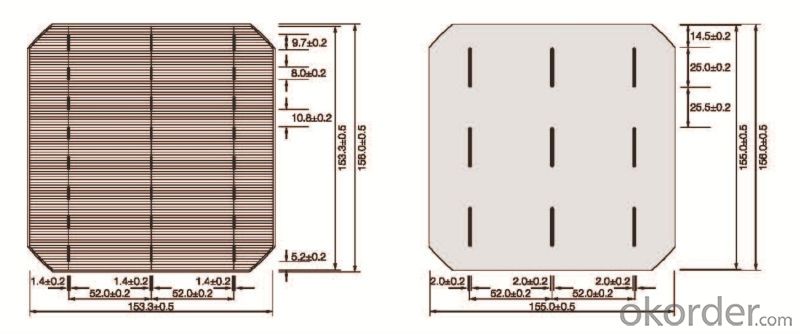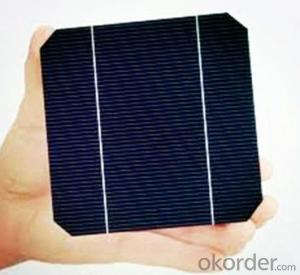Solar Cell Monocrystalline and Polycrystalline 156 with ISO9001/ISO14001/TUV/UL
- Loading Port:
- Shanghai
- Payment Terms:
- TT or LC
- Min Order Qty:
- 500 pc
- Supply Capability:
- 20000 pc/month
OKorder Service Pledge
OKorder Financial Service
You Might Also Like
| Packaging& Delivery | |
| Packaging Detail: | standard export package suitable for long seavoyage and tough handling |
| Delivery Detail: | 10-25 days depending on order quantity |
Specifications
solar cell for solar panel
1.16.8%~18.25% high efficiency
2.100% checked quality
3.ISO9001/ISO14001/TUV/UL
4.fast lead time
Our Advantage
1. High efficiency and High power.
2. Long-term electrical stability.
3. Lowest price and Fastest delivery.
4. Good quality and good service.
5.Bulk supply
6. Good Warranty
7.Big Sale
8.High quality
9.More than 35 years on the lifetime.
10 DHL/Fedex/UPS/TNT/EMS etc
Product Description
POLY6'(156*156) Multicrystalline Silicon solar celle
Diagonal: 220mm±0.5mm
Thickness(Si): 200±20 μm
Dimension: 156mm×156mm±0.5mm
Front(-) Back(+)
Blue anti-reflecting coating (silicon nitride); Aluminum back surface field;
1.5mm wide bus bars; 2.0mm wide soldering pads;
Distance between bus bars: 51mm. Distance between bus bars :51mm.
poly 156 cell Electrical Characteristics( solar cell for solar panel )
| Efficiency(%) | 18 | 17.8 | 17.6 | 17.4 | 17.2 | 16.8 | 16.6 | 16.4 | 16.2 | 16 | 15.8 | 15.6 |
| Pmpp(W) | 4.33 | 4.29 | 4.24 | 4.19 | 4.14 | 4.09 | 4.04 | 3.99 | 3.94 | 3.9 | 3.86 | 3.82 |
| Umpp(V) | 0.53 | 0.527 | 0.524 | 0.521 | 0.518 | 0.516 | 0.514 | 0.511 | 0.509 | 0.506 | 0.503 | 0.501 |
| Impp(A) | 8.159 | 8.126 | 8.081 | 8.035 | 7.99 | 7.938 | 7.876 | 7.813 | 7.754 | 7.698 | 7.642 | 7.586 |
| Uoc(V) | 0.633 | 0.631 | 0.628 | 0.625 | 0.623 | 0.62 | 0.618 | 0.617 | 0.615 | 0.613 | 0.611 | 0.609 |
| Isc(A) | 8.709 | 8.677 | 8.629 | 8.578 | 8.531 | 8.478 | 8.419 | 8.356 | 8.289 | 8.22 | 8.151 | 8.083 |

MONO6'(156*156) Monocrystalline silicon solar cell
Thickness(Si): 200±20 μm
Dimension: 156mm×156mm±0.5mm
Diagonal: 200mm±0.5mm (round chamfers)
Front(-) Back(+)
Blue anti-reflecting coating(silicon nitride); Aluminum back surface field;
1.3mm wide bus bars; 2.0mm wide soldering pads;
Distance between bus bars: 52mm. Distance between bus bars :52mm.
mono 156 Electrical Characteristics( solar cell for solar panel )
| Efficiency(%) | 20 | 19.2 | 19 | 18.8 | 18.6 | 18.4 | 18.2 | 18 | 17.8 | 17.6 | 17.4 | 17.2 |
| Pmpp(W) | 4.59 | 4.54 | 4.49 | 4.45 | 4.4 | 4.35 | 4.3 | 4.26 | 4.21 | 4.16 | 4.11 | 4.08 |
| Umpp(V) | 0.541 | 0.54 | 0.538 | 0.535 | 0.533 | 0.53 | 0.527 | 0.523 | 0.519 | 0.518 | 0.516 | 0.514 |
| Impp(A) | 8.484 | 8.407 | 8.346 | 8.318 | 8.255 | 8.208 | 8.159 | 8.145 | 8.112 | 8.031 | 7.95 | 7.869 |
| Uoc(V) | 0.64 | 0.639 | 0.638 | 0.637 | 0.636 | 0.634 | 0.632 | 0.631 | 0.63 | 0.629 | 0.628 | 0.627 |
| Isc(A) | 8.972 | 8.959 | 8.936 | 8.912 | 8.875 | 8.83 | 8.805 | 8.787 | 8.775 | 8.695 | 8.615 | 8.535 |

FAQ
1, What’s price per product ?
A: It’s depends on the quantity, delivery date and payment terms of the order. We can talk further about the detail price issue. Our products is high quality with lower price level.
2, How to make payment?
We accept T/T or L/C.
3, What is your lead time?
Generally 1-5 weeks depends on the order quantity and your specific requirements.
4, Can you do OEM for us?
Yes, we can.
5, How do you pack your products?
We have rich experience on how to pack the panels to make sure the safety on shipment when it arrives at the destination.
With the reduction of non-renewable energy sources, environmental pollution is worsening; people gradually increased the demand for renewable energy. Solar energy is a form of renewable energy, with rich resources and environmental advantages of clean, so that the solar cell has become the focus of research. Thin film solar cell price is low. The thin film solar cells with its low price, lightweight, low consumables and so much good low light response have obtained many researchers’ attention.
Brief introduction of Thin Film Solar Cell
First need to define the scope of the thin film solar cell, the solar cell is the first generation of single crystal or polycrystalline silicon cells, a second generation solar cells using a material having a large absorption coefficient, thickness of the cell not thick enough to absorb sunlight, so called thin film solar battery. Depending on the light-absorbing material, a common classification of thin film solar cells is: cadmium telluride (CdTe), copper indium gallium selenide (CIGS), dye-sensitized (DSSC) and organic polymers (OPV) solar cells. Various types of batteries are also being studied preparation process to reduce costs, so each type of cell production method is not unique.
Thin film solar cell is to be able to charge the battery through the solar thin film, which is generally the same with thin film thickness, usually black or dark. Mainly used in construction, military, travel, defense, power supply and other purposes.
Advantages of Thin Film Solar Cell
1. In low light the extent of its power generation performance is very good.
2. In the case of the same light intensity as compared with other batteries and less power loss.
3. The thin film solar cell has a very good power temperature coefficient.
4. The light transmission and generation capacity, only a small amount of silicon feedstock and the production time.
5. Internal short-circuit problem does not occur.
6. Volume thin film solar cells, generally raw materials, building materials, and can be integrated with the application.
- Q:Can solar cells be used for powering disaster relief operations?
- Yes, solar cells can be used for powering disaster relief operations. Solar cells are a reliable source of renewable energy that can provide electricity to critical facilities such as hospitals, shelters, and communication systems in disaster-affected areas. They are portable, easy to deploy, and can operate independently from the grid, making them ideal for emergency situations where power supply is disrupted. Solar-powered systems can also reduce reliance on fossil fuels, mitigate environmental impact, and ensure a sustainable energy solution during disaster relief operations.
- Q:Can solar cells be used for powering mining operations?
- Yes, solar cells can be used for powering mining operations. Solar energy can be harnessed through photovoltaic cells, which convert sunlight into electricity. By installing solar panels, mining operations can reduce their dependence on fossil fuels and lower their carbon footprint. Solar power can be used to run equipment, lighting, and other electrical systems required for mining operations. Additionally, solar energy can be stored in batteries for use during non-sunlight hours, ensuring a continuous power supply.
- Q:Can solar cells be used to power remote disaster response systems?
- Yes, solar cells can be used to power remote disaster response systems. Solar cells are a reliable and sustainable source of energy, especially in areas where access to electricity may be limited or disrupted due to natural disasters. By harnessing the sun's energy, solar cells can provide power for various critical systems such as communication equipment, lighting, medical devices, and water purification systems in remote disaster-stricken areas. This helps in facilitating efficient and effective disaster response efforts, enabling responders to provide crucial aid and support to affected communities.
- Q:PV: the battery to the battery charge problem
- Yes, for example: the battery voltage is 12V, with a 18V solar panels connected to the battery voltage will be slightly higher than the 12V voltage, such as 12.2V look, so the actual working voltage of the solar panels by the
- Q:What is the impact of pollution or smog on solar cell performance?
- The impact of pollution or smog on solar cell performance is significant. These environmental factors can reduce the amount of sunlight reaching the solar cells, leading to a decrease in their efficiency. Airborne particles, such as dust, soot, and pollutants, can deposit on the surface of the solar panels, blocking and scattering the sunlight. This reduces the absorption of solar radiation and hampers the conversion of light into electricity. Additionally, smog can further diminish solar cell performance by creating a haze that limits the clarity and intensity of sunlight. Overall, pollution and smog can have a detrimental effect on the efficiency and output of solar cell systems.
- Q:How are solar cells made?
- Solar cells are typically made by using a combination of silicon, metal conductors, and anti-reflective coatings. The process involves depositing layers of these materials onto a substrate, which is then cut into individual cells. These cells are then assembled into solar panels, which can convert sunlight into electricity.
- Q:Can solar cells be installed on any type of roof?
- Yes, solar cells can be installed on almost any type of roof, including flat roofs, sloped roofs, metal roofs, tile roofs, and even asphalt shingle roofs. However, the specific installation process may vary depending on the type of roof and its structural integrity. It is always recommended to consult with a professional solar installer to assess the feasibility of installation on a particular roof type.
- Q:How do solar cells impact energy security?
- Solar cells positively impact energy security by providing a reliable and sustainable source of electricity. As they generate power from sunlight, solar cells reduce dependence on fossil fuels, which are finite and contribute to environmental degradation. By diversifying the energy mix and promoting renewable energy adoption, solar cells enhance energy resilience and reduce vulnerability to price fluctuations and supply disruptions. Additionally, solar cells can be deployed in remote areas, increasing access to electricity and improving energy security for off-grid communities.
- Q:Can solar cells be used in vehicles?
- Yes, solar cells can be used in vehicles. Solar cells can be integrated into vehicles to generate electricity from the sun's energy, which can be used to power various components of the vehicle such as the battery, air conditioning, or even the entire propulsion system. This helps reduce reliance on fossil fuels and decreases greenhouse gas emissions, making solar-powered vehicles an environmentally friendly alternative.
- Q:What is the effect of dust or dirt on solar cell performance?
- The presence of dust or dirt on solar cell surfaces can significantly decrease their performance by reducing the amount of sunlight reaching the cells and interfering with the efficient transfer of electrons. This can lead to a decrease in the overall power output of the solar system. Regular cleaning and maintenance are essential to ensure optimal performance and maximize energy production.
1. Manufacturer Overview |
|
|---|---|
| Location | |
| Year Established | |
| Annual Output Value | |
| Main Markets | |
| Company Certifications | |
2. Manufacturer Certificates |
|
|---|---|
| a) Certification Name | |
| Range | |
| Reference | |
| Validity Period | |
3. Manufacturer Capability |
|
|---|---|
| a)Trade Capacity | |
| Nearest Port | |
| Export Percentage | |
| No.of Employees in Trade Department | |
| Language Spoken: | |
| b)Factory Information | |
| Factory Size: | |
| No. of Production Lines | |
| Contract Manufacturing | |
| Product Price Range | |
Send your message to us
Solar Cell Monocrystalline and Polycrystalline 156 with ISO9001/ISO14001/TUV/UL
- Loading Port:
- Shanghai
- Payment Terms:
- TT or LC
- Min Order Qty:
- 500 pc
- Supply Capability:
- 20000 pc/month
OKorder Service Pledge
OKorder Financial Service
Similar products
New products
Hot products
Related keywords




























